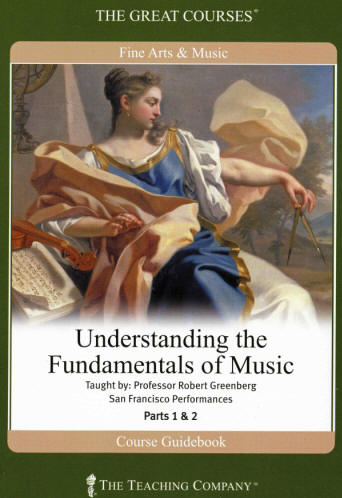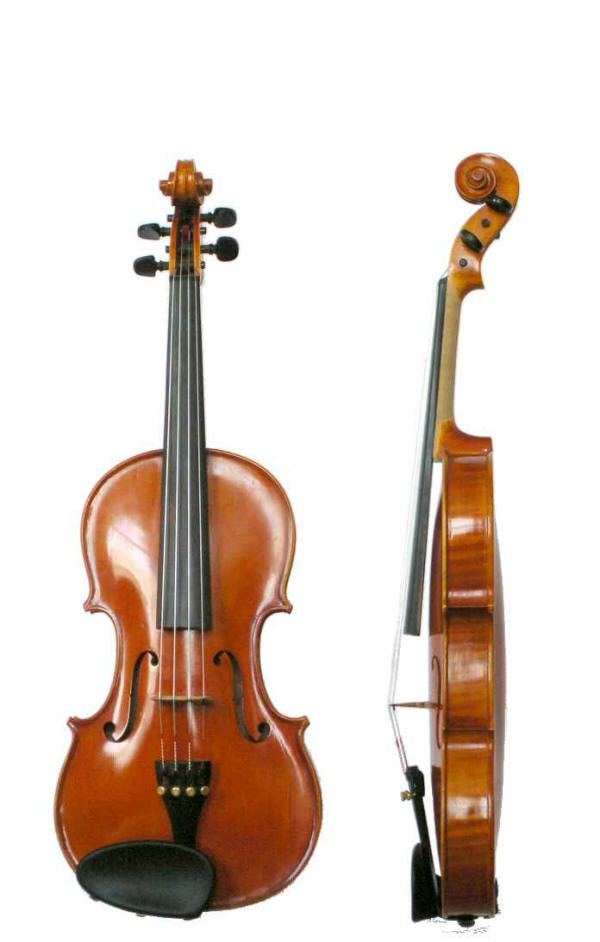|
You are reading the older HTML site Positive Feedback ISSUE 43may/june 2009
The Teaching Company:
The Great Courses - Understanding the Fundamentals
of Music
I don't normally start an article with a conclusion and a recommendation, but here goes: Please, please, read this article all the way through and buy the Understanding the Fundamentals of Music DVD set ($69.95). Buying this DVD set may be the single most important thing you ever do in audio, and it will transform your musical and Hi-Fi sensibilities for the good regardless of how long you've been in the hobby—very, very, highly recommended. Ok, now that I've got that off my chest, lets go on.
I don't know if you've heard of The Teaching Company before, but in any case, you're in for a treat. Thomas M. Rollins founded the Teaching Company in 1990. Rollins, a former Chief Counsel of the United States Senate Committee on Labor and Human Resources, is an advocate of lifelong learning. Rollins goal was to make available great courses taught by a selection of the greatest professors in the world on DVD (and other formats) to encourage people to continue learning throughout their life. The Teaching Company has identified what they believe are the top teaching professors in the USA, and then have brought them into the studio to record their courses. At this time the Teaching Company offers approximately 250 courses and thousands of hours of material in the areas of literature, philosophy, history, fine arts, the sciences, economics, and religion. I have purchased seven courses from the Teaching Company now, and they have all been uniformly excellent, and the best part is that there are no exams!
Understanding the
Fundamentals of Music The course I'm discussing today is rather unassumingly titled Understanding the Fundamentals of Music, which does not do justice to its brilliant content. Understanding the Fundamentals of Music is something every musician, music lover, and Hi-Fi nut ought to have in his or her collection and periodically review. The course consists of sixteen forty-five minute lectures taught by Dr. Robert Greenberg of San Francisco Performances, whom did his Ph.D. work in music composition at the University of California at Berkeley. Dr. Greenberg is a superb professor who continually amazed me during his lectures with his knowledge, insights, humor, musical talent, and obvious love and enthusiasm for music—this is learning and entertainment at its best. The Understanding the Fundamentals of Music DVD set sells at full retail for $254.95, but is routinely available at the sale price $69.95, a bargain considering the quality and content of this course. If it's not on sale when you go to The Teaching Company web page, just wait a little while and it will be. The Understanding the Fundamentals of Music course also comes with a handy course guidebook that provides a rich summary of the content of each of the lectures, and identifies the musical examples used, which allows you to build a musical library that will provide you with reference examples of the concepts discussed, and will be of immense practical value for reviewing your new found listening skills (and not to mention voicing your Hi-Fi rig to present the music as it is supposed to sound). The focus of Dr. Greenberg's course is about learning the language of music through using one's ears, which is something of particular interest to me, and I think, to the readers of Positive Feedback Online. While Dr. Greenberg's lectures use primarily classical music for examples, what is taught applies to every musical genre. So whether you enjoy classical, jazz, rock, folk, bluegrass, blues, or what-have-you, you'll come away with knowledge and new listening skills that will enrich every encounter with music you'll have from now on—that's big. Oh, and did I mention that the recording quality of the course is superb? It is, and that further enhanced my learning and enjoyment of the course content. The Content The Understanding the Fundamentals of Music course includes the following lectures about learning to listen to music: Lecture One – The Language of Music Lecture Two – Timbre, Continued Lecture Three – Timbre, Part 3 Lecture Four – Beat and Tempo Lecture Five – Meter, Part 1 Lecture Six – Meter, Part 2 Lecture Seven – Pitch and Mode, Part 1 Lecture Eight – Pitch and Mode, Part 2 Lecture Nine – Intervals and Tunings Lecture Ten – Tonality, Key Signature, and the Circle of Fifths Lecture Eleven – Intervals Revisited and Expanded Lecture Twelve – Melody Lecture Thirteen – Melody, Continued Lecture Fourteen – Texture and Harmony, Part 1 Lecture Fifteen – Harmony, Part 2 – Function, Tendency, and Dominance Lecture Sixteen – Harmony, Part 3 – Progression, Cadence, and Modulation Music is Sound in Time
In his first lecture Dr. Greenberg describes the learning process for 'hearing' and understanding music. Most fundamentally, music is sound in time, so we start out by learning to hear the contribution of the sonic and temporal aspects of music. Learning to hear the 'sonic' component of music centers around the ability to identify which instruments produce which sounds in the music, the timbre of instruments, and is the first step to understanding music. I might also point out that for Hi-Fi buffs, that being able to identify the natural timbre of various instruments in music is indispensible for voicing your Hi-Fi rig to 'sound' right, or more accurately, to capture the timbre of instruments faithfully (you'd be surprised how many—even very expensive—systems err in this most fundamental of musical realities). The time (or temporal) aspects of music contribute immensely to the emotional and expressive nature of music, by influencing the way our bodies feel the sound. Dr. Greenberg points out that once we begin to hear and feel how the sound (timbre) and time elements are interrelated in music, we can understand how and why we perceive the expressive meaning in music. For Hi-Fi aficionados in particular, this is huge! It means that when listening to music on our Hi-Fi rigs we will know what the music is supposed to sound & feel like, and we can tailor our system's components and voicing to achieve it.
It's Timbre, Man! In the first three lectures Dr. Greenberg begins his journey through the language of music with examples that teach you to identify—by ear—the timbre of instruments. You'll learn to identify the individual timbre of instruments from recorded examples in the five basic musical instrument categories of strings, woodwinds, brass, percussion, and keyboard. You'll learn from Dr. Greenberg what instruments are supposed to sound like (their timbre), and you'll learn to pick them out of a recorded performance.
This easy to learn ability of identifying the timbre of instruments is of tremendous value in listening to music for the purpose of enjoyment, and is also essential for learning how to voice or choose a Hi-Fi system that portrays timbres as they sound in life, which can make or break your long-term satisfaction with your Hi-Fi rig. I have found that there is an even greater performance range of Hi-Fi equipment in being able to produce realistic timbres from the musical content of recordings than there is in their ability to produce non-musical spatial recording artifacts like soundstaging, imaging, soundspace, and the like, that many Hi-Fi buffs focus on and find so intriguing and enjoyable.
By putting first things first – the music – you can voice your Hi-Fi rig so that it gets the musical content of recordings right, and then aspects of secondary importance—like the non-musical recording artifacts content—will fall into their place naturally (for the equipment setup side of this equation see Jim Smith's excellent book Get Better Sound). For example, you'll learn using Dr. Greenberg's examples, that a string quartet serves as a nice way to check out timbral believability across the violin family of instruments (two violins, viola, and cello), and that in life (and when portrayed correctly by a stereo system), a string quartet should generally sound rich, homogenous, and non-fatiguing—if it doesn't you've got some work to do tuning up your Hi-Fi rig.
It's Time, Man After having mastered the ability of identifying the timbre of the five basic instrument families by ear on a recording (you'll be pleasantly surprised how easy it is), you'll next move through lectures four through six with Dr. Greenberg to explore the nature of beat, meter, tempo, syncopation, compound meter, additive meter, asymmetrical meter, music that does not have regular meter, and how to identify them by ear with example recordings. Take one of the fundamental time aspects of music, beat, as an example, which is defined by Dr. Greenberg as the 'shortest time division to which we can comfortably move our bodies.' The time element of beat actually causes a physiological response in our bodies, and we respond naturally to beat with movement. Example: I recently helped a friend set up a modestly priced (but high-performance) Hi-Fi system who had been without a decent one in his home for a number of years. After all the gear was setup he got out some favorite old rock & roll records and put them on the turntable and began to play them. The effect on him was immediate, he jumped up and began to dance to the beat of the music, and that's how it should be! I'll tell you what, his joyous and spontaneous response to the music with dance is how it should be for all of us when listening to music on our Hi-Fi rigs, and was one of the purest and most natural responses to good Hi-Fi I have seen in a long time—it made my heart glad to be a part of bringing the joy of music back into my friend's life. One of the things you'll learn to listen for and feel is how the different aspects of the music are supposed to affect our bodies. This is really valuable as it will help you identify how well your Hi-Fi rig does on those aspects of music that bring the sound to moving life. If your Hi-Fi rig isn't bringing you to moving life, well, now you will be armed with the knowledge of how it's supposed to be so you can get things turned around and dancing in the right direction—a priceless gift to your musical enjoyment!
It's the Tone, Man! In lectures seven through sixteen Dr. Greenberg explores why sounds in music sound the way they do, and the way those sounds affect the way we as listeners feel when we listen to music. One thing I found particularly interesting was Dr. Greenberg's discussion of noise, which he defines as too much sonic information for the brain to interpret as a singable pitch. I think that Dr. Greenberg's definition of noise has interesting implications for music listeners and Hi-Fi hobbyists. We've all heard Hi-Fi writers talk about how a component or system excels at recovering detail, provides an impressive soundstage, or has remarkable imaging, and yet fails to play music well. Why is that? There is nothing intrinsically wrong with enjoying detail recovery, soundstaging, or imaging per se, and I do myself. However, when the presentation of the non-musical sonic artifacts of the recording process (detail recovery, imaging, soundstaging, etc.) are so overt that they compete with the sonic & time elements of the instruments and music itself, I think the combination is interpreted as a kind of noise by the brain, degrading the music listening experience, because noise just isn't fun to listen to. We as listeners experience that kind of 'noise' as a Hi-Fi system that doesn't play music well, one that is mechanical or artificial sounding. However, those same recording artifacts when present in just the right not-too-obvious amount—like an herb or spice in a fine meal—add to the pleasure of the experience.
To this end, of understanding why the sounds of music sound the way they do, and why they affect the way we feel and experience music, Dr. Greenberg goes on to explore tonality, with its basic aspects of pitches and the Pythagorean collection, and then pitch collections, the major and minor modes, tuning systems, the intervals, key relationships, the circle of fifths, melody, functional tonality, harmonic progressions, cadences, and modulation—whew! That's a lot of material, but I think you'll find that with each topic covered you will have a musical revelation that will make you a better listener and allow you to fine tune the performance of your Hi-Fi system if you wish. It's the End, Man I could tell you more about the remaining topics, but I couldn't do it as well as Dr. Greenberg, so it's time to end this little essay and to repeat what I said at the start of this article: buy the Understanding the Fundamentals of Music DVD set ($69.95). Buying this DVD set may be the single most important thing you ever do in audio, and it will transform your musical and Hi-Fi sensibilities for the good regardless of how long you've been in the hobby—very, very, highly recommended.
|









